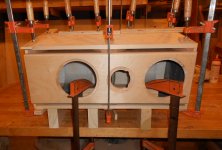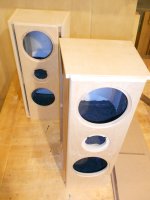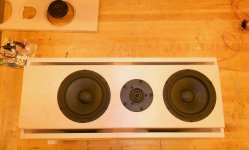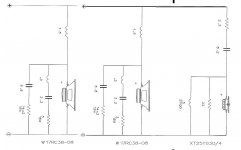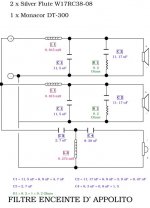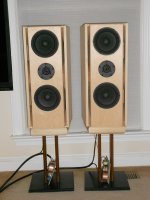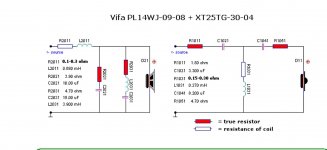Getting There
Some construction pics.
I don't have a way to measure (sorry) but the protypes sure sound great. I'll give the 6.5 SF a thumbs-up for great bass in a small box (12.5 liter per cell)
Flying saucer router base, should have done that a while ago, sure comes in handy, especially with small front baffle.
A fellow sent this to me yesterday, looks like a candidate for a dual flare box; box would be slightly bigger.
PEERLESS-NOMEX-164
Who is troelgravesen? he sure does a wonderful job with [free] plans, etc.
Some construction pics.
I don't have a way to measure (sorry) but the protypes sure sound great. I'll give the 6.5 SF a thumbs-up for great bass in a small box (12.5 liter per cell)
Flying saucer router base, should have done that a while ago, sure comes in handy, especially with small front baffle.
A fellow sent this to me yesterday, looks like a candidate for a dual flare box; box would be slightly bigger.
PEERLESS-NOMEX-164
Who is troelgravesen? he sure does a wonderful job with [free] plans, etc.
Attachments
Who is troelgravesen? he sure does a wonderful job with [free] plans, etc.
Only one of the most recommended designers on here 😉 I guess you have been too busy building stuff to have stumbled accross him till now 😀
Tony.
Well technically, I did use one of his xo's back on post #16. I thought the TB speaker worked well but sold them last week as a full range.
Been building these one at a time, looking for ways to speed up fabrication time, going super slow is not always the best thing anyway. A one day build would be nice, almost made it today.
Been building these one at a time, looking for ways to speed up fabrication time, going super slow is not always the best thing anyway. A one day build would be nice, almost made it today.
Attachments
This is fantastic, Doug. I'm starting to think YOU are the TROELS GRAVESEN of diyaudio. 😀
Are you getting enough level from the Vifa XT25 tweeter with what I assume is a LOUD parallel wired 4 ohm bass configuration?
Silver Flute W17RC38-08 6.5" Bass
FWIW, the series wired 16 ohm bass configuration has a different interaction of bass units if I've thought it through correctly. They don't need separate chambers since the interactive mode keeps them IN PHASE. The parallel wired configuration lets the bass units rock OUT OF PHASE.
I can't quite decide which is better. 🙂
Are you getting enough level from the Vifa XT25 tweeter with what I assume is a LOUD parallel wired 4 ohm bass configuration?
Silver Flute W17RC38-08 6.5" Bass
FWIW, the series wired 16 ohm bass configuration has a different interaction of bass units if I've thought it through correctly. They don't need separate chambers since the interactive mode keeps them IN PHASE. The parallel wired configuration lets the bass units rock OUT OF PHASE.
I can't quite decide which is better. 🙂
2.5 xo
Thanks for posting Steve.
I had the same thoughts about tweeter would probably need a bit more energy, so went back to the original 2.2r for the tweeter (had a higher value in the 2-way).
So yes 4ohm, and the bass is crazy nice (wow).
I used two chambers because I would have had to re-do the whole vent plan if I went with " one" chamber, i.e. widen them/tweak them,,,ugh to much work.
Thanks for posting Steve.
I had the same thoughts about tweeter would probably need a bit more energy, so went back to the original 2.2r for the tweeter (had a higher value in the 2-way).
So yes 4ohm, and the bass is crazy nice (wow).
I used two chambers because I would have had to re-do the whole vent plan if I went with " one" chamber, i.e. widen them/tweak them,,,ugh to much work.
Attachments
Last edited:
Just to clear up something I'm not quite following...Is that 7 or 14 or 28 ohms overall in series with the 6.8uF?
I did find another similar d'Appolito design at this French website. Not using your nice notch, of course. But it's always interesting to compare ideas:
Conception d'enceinte avec le W17RC38-08 Silver Flute
The circuit is below:
I did find another similar d'Appolito design at this French website. Not using your nice notch, of course. But it's always interesting to compare ideas:
Conception d'enceinte avec le W17RC38-08 Silver Flute
The circuit is below:
Attachments
Its a 7ohm.
I feel that the woofer(s) are cooperating.
There's been a lot of discussion about the tweeter.
Since I've gone this far, would consider a replacement.
So running them 4ohm, what would out of phase? Woofers or tweeters?
I feel that the woofer(s) are cooperating.
There's been a lot of discussion about the tweeter.
Since I've gone this far, would consider a replacement.
So running them 4ohm, what would out of phase? Woofers or tweeters?
So hear we go...these have the boxing gloves on; very nice transient response - POW! (hard to believe really)
Lost some of the tweeter level moving them inside the woofers, which is not all since that's the weak link here. However one question plz (back to post 166) is the 2.2R and the 33R a L pad?
Still have the troelsgravesen studio monitor xo here, could easily slip that in, however I think the obvious thing is to look for better tweeter.
Lost some of the tweeter level moving them inside the woofers, which is not all since that's the weak link here. However one question plz (back to post 166) is the 2.2R and the 33R a L pad?
Still have the troelsgravesen studio monitor xo here, could easily slip that in, however I think the obvious thing is to look for better tweeter.
Attachments
Essentially, yes although for it to be a text book kind would require the inductor to be on the other side of the 2r2 (the position of this resistor and the capacitor can be swapped with each other making no difference).is the 2.2R and the 33R a L pad?
The two resistors would probably have been treated as separate points of freedom in the design. Their values may have been traded at some point against each other to satisfy such things as making the final impedance more usable, allowing certain values for the C and L, allowing components of a certain power rating, or ensuring a smooth response but for practical purposes the concept of an L-Pad here would be moot.
Sometimes this kind of speaker may be configured in a way that offers somewhat more treble than is naturally required. This imparts a sharp edge to the sound that I used to believe was good transient response.transient response....Lost some of the tweeter level moving them inside the woofers,
This can be difficult to explain in words. A balanced treble would not stand out, but will have the ability to resolve the finest details available to it. It will make the speakers sound just as dull as a particular recording (or part thereof) is...but when something in the recording/music changes it will keep right up. Such a speaker might sound incapable until something exceptional is played through it, then it will surprise.
So many recordings are substandard. It's therefore important not to confuse an apparently dull sound as being the speaker's fault, unless it truly is. Too much treble is a choice that has its merits, but ultimately becomes a limitation.
Doug, another thing to be aware of is that with the MTM config the speakers will have a very narrow dispersion in the vertical plain. That is you really need to be listening with ears at tweeter level or you WILL notice that the treble seems to be rolled off.
Tony.
Tony.
Yes they are ear level now.. tweeter level is to low and all discussion about the $32 vifa and distortion has me looking.
The mid drivers are 89db - what would it add up to for 2?
I think all the nice ScanSpeak are out, only 90db. What about this?
http://meniscusaudio.com/images/mdt32s.pdf
oops the morel is 90 also.
The mid drivers are 89db - what would it add up to for 2?
I think all the nice ScanSpeak are out, only 90db. What about this?
http://meniscusaudio.com/images/mdt32s.pdf
oops the morel is 90 also.
Last edited:
Interesting; A dayton used in MTM, cost is very reasonable.
Dayton, RS28A-4
There's a misprint - only 88db
Dayton, RS28A-4
There's a misprint - only 88db
Last edited:
I assume we are talking about Troels' two versions of the Vifa PL14WJ.
Vifa PL14WJ-
He seems to just scrape it on the d'Appolito version on levels and impedance by lowering resistance in the treble filter.
Since you re struggling with tweeter level here on a 4R parallel wired d'Appolito, why not try the easier series wired 16R version? It's altogether easier to implement anyway, and I like what it does. Very easy amplifier load. 🙂
Vifa PL14WJ-
He seems to just scrape it on the d'Appolito version on levels and impedance by lowering resistance in the treble filter.
Since you re struggling with tweeter level here on a 4R parallel wired d'Appolito, why not try the easier series wired 16R version? It's altogether easier to implement anyway, and I like what it does. Very easy amplifier load. 🙂
I will continue to test, and keep this in mind. I thought if there was a L pad; just simply remove it.
Typically I just keep adjusting the high end until it sounds too bright and then go back a notch.
The stands could be higher (10") to bring the tweeters to ear level.
Thanks!
Typically I just keep adjusting the high end until it sounds too bright and then go back a notch.
The stands could be higher (10") to bring the tweeters to ear level.
Thanks!
Essentially, yes although for it to be a text book kind would require the inductor to be on the other side of the 2r2 (the position of this resistor and the capacitor can be swapped with each other making no difference).
The two resistors would probably have been treated as separate points of freedom in the design. Their values may have been traded at some point against each other to satisfy such things as making the final impedance more usable, allowing certain values for the C and L, allowing components of a certain power rating, or ensuring a smooth response but for practical purposes the concept of an L-Pad here would be moot.
Sometimes this kind of speaker may be configured in a way that offers somewhat more treble than is naturally required. This imparts a sharp edge to the sound that I used to believe was good transient response.
This can be difficult to explain in words. A balanced treble would not stand out, but will have the ability to resolve the finest details available to it. It will make the speakers sound just as dull as a particular recording (or part thereof) is...but when something in the recording/music changes it will keep right up. Such a speaker might sound incapable until something exceptional is played through it, then it will surprise.
So many recordings are substandard. It's therefore important not to confuse an apparently dull sound as being the speaker's fault, unless it truly is. Too much treble is a choice that has its merits, but ultimately becomes a limitation.
Steve's idea about running them in series for 16 ohms is a good suggestion.
When building these in the way Joseph D'Appolito described, they have a 3rd order butterworth crossover or in other words, only 3dB down at the crossover point and 90 degrees out of phase. Imagine that if the lower woofer were switched off, the tweeter and upper woofer would add in phase at some angle above the listening axis and vice-versa as this is a symmetrical design.
The upper and lower lobes will cover a wider vertical angle than a conventional two way crossover region and better match the tweeter's dispersion. When they come together on axis, since they are 90 degrees out of phase, should add to the same level as the individual lobes, with flat power and flat on-axis response.
Assuming parallel, this would give you 95dB but only when they are acoustically close to each other which means a 1/4 wavelength. Above this frequency they will lose power through cancellation starting with the extreme up and down directions, then gradually at a more shallow angle so the crossover frequency needs to be selected. The following is a generalisation (and I haven't built one of these for a long time so I may have left something out 😉)...The mid drivers are 89db - what would it add up to for 2?
When building these in the way Joseph D'Appolito described, they have a 3rd order butterworth crossover or in other words, only 3dB down at the crossover point and 90 degrees out of phase. Imagine that if the lower woofer were switched off, the tweeter and upper woofer would add in phase at some angle above the listening axis and vice-versa as this is a symmetrical design.
The upper and lower lobes will cover a wider vertical angle than a conventional two way crossover region and better match the tweeter's dispersion. When they come together on axis, since they are 90 degrees out of phase, should add to the same level as the individual lobes, with flat power and flat on-axis response.
Last edited:
Thanks Allen, that is the best explanation I have seen for the original D'appolito 3rd order crossover!! I'd never quite got my head around it before. I had seen a few time people claiming that MTM's have good vertical polar response which I thought was odd, no doubt they were propper 3rd order D'appolito designs (something that is as far as I am aware quite difficult to achieve).
in the vein of morel tweeters you might want to consider one of these --> Morel CAT 378 1-1/8" Soft Dome Horn Tweeter 277-084 93db sensitivity (basically the next generation of what I have which is a DMS37).
How did you end up doing the crossover, and does it have baffle step compo built in? You may find that with correct baffle step compensation your mids will come down a bit, lower bass up a bit, and then your tweeter will blend in very nicely.
Tony.
in the vein of morel tweeters you might want to consider one of these --> Morel CAT 378 1-1/8" Soft Dome Horn Tweeter 277-084 93db sensitivity (basically the next generation of what I have which is a DMS37).
How did you end up doing the crossover, and does it have baffle step compo built in? You may find that with correct baffle step compensation your mids will come down a bit, lower bass up a bit, and then your tweeter will blend in very nicely.
Tony.
I'm not so sure it has to be that filter. Crossing for 3dB and 90 degrees with any arbitrary filter of reasonable similarity ought to achieve the same goal.no doubt they were propper 3rd order D'appolito designs (something that is as far as I am aware quite difficult to achieve).
Hi Allen, I thought that the main issue was getting the driver to driver spacing small enough to allow for a "reasonable" crossover frequency... as the spacing goes up the crossover frequency has to come down I thought, to achieve the D'Appolito design... anything bigger than 4" mids and a very small face plate tweeter I thought required very low crossover frequencies...
Tony.
Tony.
Naturally...and the first thing that popped into my head was why not just use a tweeter that would play low, but it strikes me that this might work best if crossed high enough that the individual drivers have enough directivity not to interfere too much with the other 'half' of the lobe...but this could be a stretch.
- Status
- Not open for further replies.
- Home
- Loudspeakers
- Multi-Way
- Canned Crossover Design - What Next?
